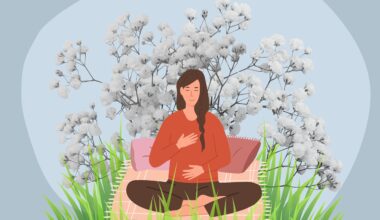Mind-Body Connection: How Mental Focus Improves Core Strength and Back Pain Prevention
Humans are remarkably capable of achieving profound physical and emotional benefits through focus and intention. Discovering the mind-body connection is paramount, especially in strengthening the core and minimizing back pain. As awareness increases, individuals can build a solid foundation that supports overall well-being. An effective core consists of muscles in the abdominal area, lower back, and hips. By anchoring attention on these muscle groups, one can evoke deep muscle engagement. This not only maximizes core strength but reinforces resilience to postural stressors. Stronger core muscles alleviate some pressure from the spine, enabling better alignment and reducing back pain. Additionally, refurbishing one’s mental focus can amplify self-awareness and body intelligence. Engaging in practices such as yoga, Pilates, or mindful breathing practices cultivates an environment where mental clarity and physicality harmonize. Participants often report decreased discomfort and enhanced posture. Setting specific intentions during exercises can highlight areas needing extra attention, thus promoting targeted muscle development. Leveraging mental focus approaches ensures individuals take active roles in their health, fostering both physical strength and mental clarity.
The relationship between mental focus and physical strength is particularly evident in the mechanisms of core training. When individuals unite their mental faculties with physical routines, the outcomes can be transformative. Vital to this understanding is the role of mindfulness. Mindfulness can enhance performance, promote connection to physical sensations, and facilitate improvements in posture. Taking time to focus on breathing during workouts can also help activate core muscles more effectively. As the mind dismisses distractions, more energy can be diverted to muscle activation. This attention is integral during movements that target core strength, such as planks, bridges, and rotational exercises. Enhancing awareness around these practices fosters improvement over time. Practitioners often feel empowered as they realize their improved capabilities, reducing reliance on external aids. Techniques including visualization can further strengthen the connection between mind and body. By picturing muscles contracting and working harmoniously, practitioners can start to cultivate a state of confidence. Engaging in this self-led dialogue not only assists in coordination but reinforces the importance of maintaining a balanced approach to fitness and long-term health.
Additionally, the literature supports the notion that mental engagement can accelerate muscle development. Research indicates that athletes who harness mental visualization techniques before physical exertion often yield greater results. For strength training, visualization can augment progress significantly. Strengthening the core lays the groundwork for improved stability and functionality throughout various activities, including daily living tasks. Recognizing this connects core exercises directly with many necessary lifestyle functions. This relationship highlights its necessity beyond mere aesthetics, incorporating physical health into overall well-being. Targeted core strengthening contributes notably to safe physical practices, as reinforced muscles support spinal alignment and decreased injury risks. Simply stated, the subconscious mind also plays a role in stabilizing behaviors and preventing injuries during engaging tasks. Individuals who have experienced back pain often benefit tremendously from restored focus on core strength development. They may also discover symbiotic effects on mental wellness. As core training becomes a priority, the improvement in overall sense of well-being emerges. Hence engaging both body and mind sets the stage not only for recovery but for thriving in everyday activities.
Practical Applications for Core Strengthening
To fully harness the effects of mental focus for core strengthening, applying practical techniques is essential. Incorporating breathing exercises into daily routines can establish a sense of mindfulness immediately. Techniques such as diaphragmatic breathing emphasize using the abdomen effectively, thus connecting mental awareness to core fortification. Engaging in slower, more deliberate movements during workout sessions could further enhance awareness. It empowers participants to tune into their bodies while executing exercises mindfully. This meticulousness might include slowing down during a plank by focusing solely on comprehensive breathing and muscle activation patterns. This approach also paves the way for refining workout strategies over time. Furthermore, utilizing fitness apps or guided classes offers led instructions. These tools may include features designed for focus, such as audio cues or video demonstrations emphasizing form. Maintaining a journal detailing progress and experiences may also serve as a reflective practice that fosters mental growth alongside physical. Recording insights surrounding strengths, challenges, and feelings towards core workouts enables enhanced objective understanding of personal fitness journeys.
Moreover, integrating community-based activities provides crucial social benefits while strengthening mental focus. Engaging in group classes or workshops promotes accountability and encouragement, simultaneously allowing individuals to share challenges. Activities such as yoga or martial arts inherently require mental focus and foster environments where togetherness flourishes. Within supportive communities, participants often recognize shared experiences, enhancing emotional and motivational aspects of their fitness journeys. This sense of belonging can help individuals cultivate stronger mind-body connections, magnifying the impact of core training practices. Additionally, activities that prioritize personal connections pave the way for open dialogue on health and wellness. These interactions may help uncover shared insights regarding core strength’s role within back pain prevention. Engaging with instructors and like-minded peers allows individuals to learn from experienced practitioners. Offering personal testimonials and advice can yield additional support and guidance. Recognizing community can also influence motivation levels positively, creating a sustained commitment to an exercise regimen. Regardless of individual backgrounds, everyone can support, learn from, and grow with one another while working towards enhanced core strength and reduced back pain.
Concluding Thoughts on Back Pain Prevention
Ultimately, enhancing core strength through mental focus is a dynamic approach to preventing back pain. As individuals recognize the interconnectedness of mind and body, they inevitably become active participants in their well-being. This empowerment translates to tangible benefits both physically and mentally, reducing back pain while fostering a more profound appreciation of body capabilities. Emphasizing mental strategies alongside physical routines culminates in holistic approaches, ensuring comprehensive well-being. Mind-body practices, such as yoga, pilates, and tai chi, allow practitioners to integrate aspects of focus, balance, and core engagement cohesively. The simple act of shifting mental attitudes to cultivate positivity lays groundwork for a flourishing fitness experience. Each individual’s journey emphasizes unique growth and development, highlighting core strength’s role in overall wellness. As practitioners endeavor to stay engaged with mental focus as they build core strength, a sustainable lifestyle emerges. The mindset cultivated influences confidence levels, hones physical capabilities, and ultimately promotes resilience to prevent back pain. By redefining personal relationships with exercise, awareness grows while laying the foundation for success. Armed with knowledge and purpose, practitioners can navigated their holistic wellness journeys effectively.
In conclusion, the mind-body relationship proves invaluable in not only maintaining but enhancing core strength while preventing back pain. The attention placed on core muscles, combined with mental engagement, leads to better alignment and overall well-being. Practitioners can adopt various techniques to solidify this relationship and cultivate awareness during workouts. Establishing routines that include mindfulness exercises, focus-driven workouts, and community engagement can vastly improve individual experiences. Each of these approaches contributes to building a stronger core while prioritizing mental health as equally significant. The continuous exploration of personal growth occurs when fitness becomes a holistic venture. This notion transcends the concept of just exercising for appearance and embraces the idea of exercise fostering emotional and physical health. Working diligently on core strength builds a firm foundation not just for physical activities but enriches life’s journey as a whole. Individuals can discover that a solid core encompasses both physical strength and mental clarity. Continued exploration underlines the importance of integrating mental focus into core training, emphasizing the holistic nature of fitness. By harnessing this unity, individuals engage actively in their journeys toward wellness, achieving resilience, confidence, and enhanced quality of life.
Mindfulness and mental focus create the pathway to a stronger core. As individuals connect their thoughts with movement, they build a resilient support system for the spine, overcoming potential back pain. Maintaining awareness of core muscles not only aids in movement but lays the groundwork for healthier lifestyle choices overall. Through commitment and practice, people can notice profound changes and improvements in both physical and mental well-being. Engaging with core exercises enables practitioners to step into newfound confidence in their bodies and lives. Fostering this relationship leads to not just an improved physical state, but sets the tone for emotional health and stability. Connecting the mind to the core body creates a balanced foundation essential for navigating everyday activities without pain. The persistent pursuit of mental focus and mindfulness during core workouts emphasizes the significance of self-care and self-love within each individual. This approach integrates wellness philosophies that honor both strength and gentleness simultaneously. Ultimately, enhancing core strength and preventing back pain transcends the realm of physical fitness. It creates a harmonious existence where body, mind, and spirit thrive together, paving the way for a fulfilling life.


